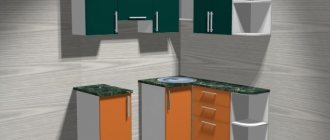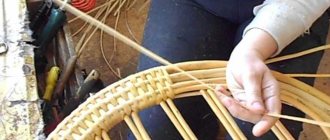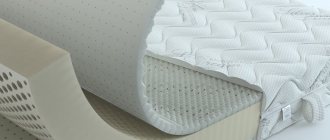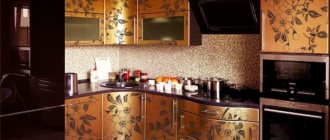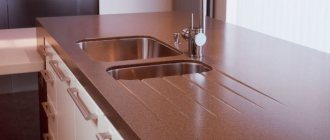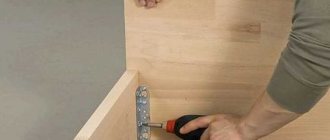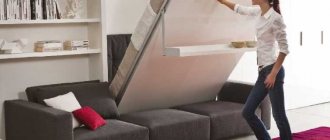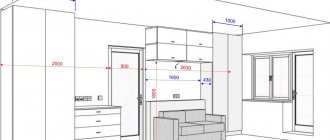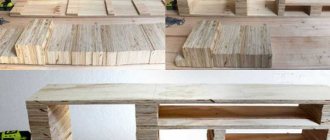30.04.2019
To organize furniture production from scratch, you need to have a clear understanding of furniture manufacturing technology . A properly organized enterprise can generate stable income for its owner for many years. Let's consider the main stages of the manufacturing process of cabinet furniture products.
Tools, equipment
Even a small enterprise that will be engaged in the manufacture of single pieces of furniture will not be able to get by solely with hand tools. Equipment purchases typically account for the bulk of costs. Experienced furniture makers believe that to produce high-quality products in accordance with all the rules of technology and cabinet furniture production, you cannot do without:
- format-cutting machine for cutting elements of hull assembly;
- edge banding installation for edging parts made of wood boards;
- drilling and additive machine for drilling holes for fasteners;
- drying chamber for drying lumber.
In addition, you will need equipment for glass processing: a sandblasting machine, devices for cutting and drilling sheet glass. Don’t forget about hand tools, which include:
- screwdriver;
- Grinder;
- furniture stapler;
- jigsaw;
- shoe knives for cutting thin materials;
- measuring instruments: tape measures from 2 to 5 m, steel rulers and squares;
- thick scribe awl;
- rubber and metal hammers;
- clamps for fixing parts with a grip of at least 100 mm;
- flat and Phillips screwdrivers of different lengths and thicknesses, hex keys for confirmations, pliers, wire cutters;
- cutters, drills of various diameters, including a Forsnel drill, discs for a cutting machine;
- sanding belts of different abrasiveness classes.
In the process of further work, the need to replenish the fleet of equipment and tools corresponding to the complexity and scale of the tasks being solved will certainly become clear.
Accessories
Furniture fittings are all kinds of fasteners, handles, curtains, supports and decorative elements. They are made of metal, wood, plastic and other materials. Metal products are treated with special anti-corrosion agents to extend their service life. For luxury-class designs, the fittings can be gold-plated or silver-plated, as well as trimmed with rhinestones, crystal or natural stones. Conventionally, fittings can be classified by type.
Connecting fittings – connects and fixes parts together. This group includes one-piece, detachable and movable elements:
- Permanent connections include screws, ties, screws, nails, bolts, brackets, hooks, upholstery buttons of upholstered furniture. The tie can be eccentric or connecting. Galvanized steel is used for the eccentric tie and makes it durable. The corner tie does not require additional holes in the ends of the furniture. Threaded ties include a nut and a screw that create a strong connection. A wedge coupler is also used for quick connection. It is based on plates, wedges and staples. The ties are connected with traditional screws;
- Detachable connections ─ these are door handles, latches, shelf holders, magnetic devices, locks, bolts. To fasten detachable structures, screws and self-tapping screws are used;
- Movable ─ these are hinges, “rails” for parallel movement of the door, microlifts. Pneumatic mechanisms and ball-bearing guides take on the entire load.
For furniture made from chipboards, it is not recommended to use piano hinges, which were used several decades ago. Today, manufacturers use four-joint designs called "frog". They can withstand a 10,000th door opening/closing cycle.
Detachable
Movable
One-piece
Rotating elements ─ these include carousel mechanisms, structures for moving tabletops apart, for directing the movement of products. For example, the shelf rotates along its axis and makes it easy to get the desired item. Basically, furniture structures are built using guide systems, which are used to pull out elements. They can extend fully or partially. Thanks to special rollers, such systems operate smoothly and almost silently. They are made of steel, fluoroplastic or duralumin. If we consider the importance of fittings as a percentage of the cost of cabinet, upholstered and kitchen furniture, we get the following results: in cabinet furniture, fittings account for 10-15% of the total cost of the product. For a kitchen, the importance of fittings is 25% of the cost of the set, and for upholstered furniture it is 30-40% of the cost of the product.
Rotary
Accessories for assembly ─ when purchasing furniture, you need to pay attention to the accessories and upholstery fabric, determine their quality and strength. And also on the assembly details of the product, which include furniture corners, confirmants, rafixes, minifixes and dowels:
- Furniture corners are simple, cheap and affordable types of connections. On the construction market they are presented in different sizes, made of plastic and metal. Corners are designed for fastening hinged parts in pencil cases and cabinets. They are easy to install, have a low price, but are noticeable, which slightly spoils the design of the structure;
- Confirmat is a furniture European screw, which received its name from the German manufacturer. A furniture screw tie, consisting of a steel rod with a blunt ring, a head and a massive thread, is capable of connecting several wooden elements at once. The confirmation is visible in the design, so it is masked with a plug. The most common are screws with dimensions of 7x50 mm or 6.3x50 mm;
- A dowel is a connecting element that is used for assembling wooden, plywood, and chipboard furniture parts. It is made of hardwood and has a cylindrical shape with chamfers. Today plastic dowels are also produced. They strengthen furniture connections with confirmat, minifix and rafix. Used with PVA glue as an independent fastening element;
- Minifix ─ is an eccentric coupler for furniture joints, consisting of two parts ─ a rod and an eccentric. Minifix has a different design, which makes it possible to increase the length of the element and connect it at different angles. For installation, use a Ø15 mm cutter and drills, with which three holes are drilled. The fastening turns out to be complex and requires precise calculation;
- Rafix ─ is used in visible places to connect furniture parts of tabletops, side parts of furniture structures. It is installed on two holes, has an eccentric mechanism and a rod. Rafix has a beautiful aesthetic appearance, but it is not particularly durable.
Dowel
Rafix
Minifix
Furniture corners
Minifix
Design of cabinet furniture and selection of materials
To quickly develop projects for furniture products, special computer programs are used. Today it is not difficult to choose the right software for making furniture, since the market for these software products is extremely large. Many programs are available in a free version, which allows you to save money at least at the initial stage. Some of them allow you not only to develop drawings and visualize them in volumetric form, but also to calculate project estimates for different materials.
At the design stage, the appearance and functional elements of the furniture are determined, the overall dimensions of the product and the materials from which it will be made are selected. Based on the project, fittings and fasteners, decor and inserts, and other details are selected. Drawings of product elements for cutting are made, and an assembly flow chart is drawn up.
Equipment
Starting a business begins with finding money to purchase equipment. You should not cooperate with other workshops for cutting materials, which will entail additional waste and increased costs. In this case, competitive advantages are reduced to nothing. It’s worth finding out in advance how to open a furniture production shop and invest your money profitably.
To save on waste, you can purchase used equipment, which will cost 30-50% less. You will need to purchase the following machines:
- Drying - if you plan to use natural wood in your work, which is pre-dried.
- Band saw – performs precise cutting of wood, chipboard, MDF.
- Machines for decorating, which helps to give the desired shape to wood and cut chamfers.
- Devices that help you work with glass.
- Machines for working with metal materials.
- Sewing machines.
- Tools.
During the work, chipboard, fiberboard, MDF sheets, fittings, fasteners, varnishes, and paints will be used.
Software
Visualization of the production process can be organized using computer programs. They will allow you to quickly model various objects in 3D format. Designers will always be able to demonstrate furniture to the customer. You can use the Pro100 program.
Cutting blanks
Modern furniture, as a rule, is made from wood panels, so an important stage in its production is cutting - the process of cutting out parts from a solid chipboard board. It is best to do this using a cutting machine, since it will cut the slab with maximum accuracy. The cutting is carried out in accordance with the drawing, the chipboard sheet is pre-marked to the dimensions of the parts. Curvilinear sections are cut with a jigsaw.
Attracting clients
You need a business plan for furniture production; you can view it from trusted sources. It is important to create a marketing plan that will help you sell your product profitably. It is important to properly organize activities to find potential clients.
To successfully sell finished products, you must:
- Organize an exhibition stand in the office or open your own mini-shop;
- Cooperate with small retail outlets where you can sell furniture;
- Work with tenders;
- Attract large private clients;
- Create a website, a group on social networks, where the features of the work are described, contact information, and a furniture catalog is compiled;
- Using classic advertising consisting of leaflets, banners;
- Advertising on radio, television, media.
Machining the ends of parts
The outer ends of the parts must be covered with a special edge tape, which will cover the unaesthetic cut and serve as an obstacle to moisture getting inside the chipboard. Pasting is carried out on a special edge banding machine, where gluing occurs with heating, which means that the requirements of cabinet furniture manufacturing technology .
In the absence of a machine, the edge is heated with an iron or an industrial hair dryer, but in this case there is no talk of decent quality due to uneven heating. On the machine, simultaneously with gluing, the edge is trimmed if its width is too large. When gluing with an iron, trimming is done manually with a shoe knife, which sometimes leads to the formation of burrs on the edge. Therefore, a mandatory step in gluing the edges is sanding the cuts with fine sandpaper until completely smooth.
Manufacturing
To successfully make cabinet furniture with your own hands, you must carefully follow all the steps:
- preparation of parts;
- processing of sections;
- marking of fittings;
- installation.
Having completed the calculations and begun assembling the product, in no case should you work without a drawing or act at your own discretion. If a new idea arises, you should create another diagram that will take into account all the amendments.
Preparing parts
When working from scratch, you first need to cut out the furniture parts - thick paper or cardboard will do. Next, you will need a high-performance machine with a high cutting frequency. Having placed the workpieces on it, you need to cut the material, saving space if possible. This will help reduce wood costs.
Ready-made options can be found in furniture departments and on the market. In this case, no machines will be required. If the raw materials are not processed, then the parts must first be covered with self-adhesive film or special plastic.
Cut out parts
Cut
Processing slices
Before you start assembling the parts, you need to glue the sections. For this you will need edge tape. Before work, you need to make sure that the humidity in the room is low - it is advisable to dry and warm the workshop well. You will also need equipment; a regular iron and a construction knife will do. Sometimes the edge is initially equipped with a sticky layer, then there is no need to further treat the surface.
How to properly arrange furniture in a room, designer tips
During gluing, the iron should be kept at a short distance from the cut to prevent possible displacements and to secure all parts well. If you overexpose it, the edge may overheat and burst. When it is fixed, use a knife to trim the edge and smooth out all the irregularities.
Tape over the sections
Trim edge
Clean up uneven areas
Marking of fittings
Correct technology involves placing the finished parts of future furniture on a flat surface for marking. Following the plan, you need to mark all the places where the fittings will be attached. It is advisable to double-check the dimensions, since an error of 1 cm can distort the entire structure. Next, you need to make holes in the marked places and screw in the fittings.
Mark and drill holes
Screw in the fittings
Installation
In accordance with the plan, the cut parts must be connected. For screeding, it is important to prepare a screwdriver with special attachments. This way the twisting will happen much faster than with a screwdriver. Nails should not be used to strengthen the bottom. The best choice would be self-tapping screws measuring 4 by 16. All edges must be fastened at an angle of 90 degrees using corners. You can nail the back wall to the assembled frame.
In order for the sliding mechanisms to operate smoothly, the guides must be properly fixed. They should be attached parallel to the horizontal edges of the product. Then attach special rollers to the doors, the movement of which checks the operation of the entire mechanism. After installing the sliding system, the furniture begins to shrink, which can cause gaps to appear. This is considered normal and depends on the characteristics of the material.
All that remains is to attach the fittings. All shelves, hooks and drawers must be installed in their places. The product is ready for use. Even an inexperienced person can handle the design of cabinet furniture.
Making cabinet furniture allows you to acquire useful skills that in the future will help you create entire sets for various rooms. All products in the house will have a unique design that will surprise and delight guests. For example, assembling a cabinet takes no more than 3 hours for novice craftsmen.
Selection and installation of accessories
The parts are marked for subsequent drilling of mounting holes, and then the drilling itself is carried out. When measuring distances, high accuracy is necessary so that later, during assembly, there are no distortions. After marking, the holes are drilled on a drilling machine, which does not allow the drill to be deepened beyond the required depth. The holes are thoroughly cleaned of dust and sawdust.
The correct choice of fittings is extremely important when making furniture, because the functionality of the product depends on it. Doors should open easily and close securely, drawers should pull out without distortion or getting stuck. The design of the fittings is chosen in accordance with the overall style of the furniture. The fittings are fastened using a screwdriver.
Cabinet furniture: high demand and abundance of offers
The demand for cabinet furniture is currently very high. In general, it is always quite high, but the current increase in interest is due to the revival of the market for new housing construction.
When buying a new apartment or renovating an old one, purchasing new cabinet furniture is almost inevitable. This is the basis of any interior.
Cabinet furniture is all furniture made from solid modules installed and fastened horizontally and vertically. This type includes:
- cabinets;
- buffets;
- headsets;
- storage areas;
- racks, “walls”, shelves, bedside tables;
- dining and desk tables.
At the same time, in modern conditions one cannot complain about the lack of supply. Both small workshops and huge corporations actively sell their furniture. The furniture manufacturing business exists in a highly competitive environment - this is the main reason for the closure of most start-up businesses. Therefore, before trying to realize yourself in this area, it is worth drawing up a business plan, analyzing costs and taking into account all the pros and cons.
Cabinet furniture is all furniture made from solid modules.
Assembly of cabinet furniture
Unlike the technology for manufacturing upholstered furniture , which includes cutting and sewing upholstery, cabinet furniture consists only of solid elements, for assembly of which metal fasteners and wooden dowels are used. It is important that workers follow the established order of connecting parts. First, the frame elements are connected, then the back walls are attached to them, mirrors and glass inserts are installed, and the fittings are checked for correct fastening. Then they install retractable elements - drawers, roll-out shelves, etc.
Compliance with all requirements of cabinet furniture production technology is the key to high-quality assembly.
Customers will definitely appreciate the quality and impeccable appearance of the products, which will very soon have a positive impact on the number of applications and the growth of the furniture company’s profits.
Registration: management forms, OKVED and documents
For the production of cabinet furniture, you can register an LLC or individual entrepreneur. The form of business management depends on the scale of the enterprise. If mass production is planned, then LLC will be optimal. If the products will be made to order and in small batches, then individual entrepreneur is better.
To register with the Federal Tax Service you will need to provide:
- Charter and constituent documents (for LLC).
- Receipt for payment of state duty: 800 rubles. for individual entrepreneurs, 4000 for LLC.
- Bank details: bank accounts.
- Application form P21001 for opening an individual entrepreneur or P11001 for an LLC.
When registering, you also need to indicate OKVED codes.
For production.
- 36.12 - furniture for offices and retail establishments.
- 36.12 - for the manufacture of kitchen furniture.
- 36.14 - production of other furniture.
For sale.
- 52.44.1 - retail sales.
- 51.47.11 - wholesale sales.
- 52.61.2 - retail sale through teleshopping, radio, online stores or by telephone.
In addition to the Federal Tax Service, you must register with the pension fund. Do not forget about the mandatory authorized capital for an LLC - from 10,000 rubles.
“If registering a business seems like a complicated and time-consuming process, then it can be delegated to a law firm. The lawyers will carry out all the necessary procedures themselves and hand over the completed documents to you.”
Joinery production technology
Each workplace is provided with technological documentation, on the basis of which the worker performs the assigned operation.
The documentation includes a technological map and a working drawing.
The technological map must contain the following data: product name; number and name of the part (or half-assembly); the name of the operation to be performed; number and name of the workplace to which this card is received; listing the main and auxiliary materials that will be used for a unit or series of parts to be processed; names and characteristics or symbols of instruments and devices (clamps, samples, control devices, etc.) necessary for the operation; time limit for this operation; the retail price for the operation, as well as the production level of the worker; name and number of parts processed simultaneously; number of shifts
Stages of the technological process.
Each enterprise producing carpentry products must have a place for storing and maintaining raw materials or a special warehouse; if the raw material is not dry, you need to reduce the percentage of moisture in it to the level specified by the technical specifications for this product, or you need to dry it. The boards are cut into pieces of a certain length, and the pieces of boards are machined. The processed parts are connected into half-assemblies and subassemblies, which are then assembled into finished products. The connection of parts into half-assemblies, units and finished products in different sequences is accompanied by finishing the surface of the product. Finished products are packaged and sent to warehouse.
The listed groups of technological processes are most often found in the production of joinery products. However, depending on the type of production, the order of the listed groups changes; some of these groups disappear or, on the contrary, new groups of technological processes are added.
The entire technological process for the production of joinery products can be divided into the following stages: 1) storage (combined with curing) of materials; 2) sawing lumber into pieces (initial processing); 3) drying and aging; 4) machine processing; 5) assembly of half-assemblies and assemblies; 6) assembly of the entire product; 7) finishing the surface of the product; packaging and warehousing of finished products.
2) sawing lumber into pieces (initial processing); 3) drying and aging; 4) machine processing; 5) assembly of half-assemblies and assemblies; 6) assembly of the entire product; 7) finishing the surface of the product; packaging and warehousing of finished products.
Sawing and drying can be done in reverse order.
Lumber from hardwood most often must undergo an initial process - sawing into pieces, and then, if technical conditions allow, steaming in chambers (during steaming, the wood changes color slightly - it darkens, which is not always acceptable); After this, the wood is subjected to forced drying in drying chambers and aging.
Coniferous lumber of small thickness can first be dried and then sawed immediately after. True, at this time unnecessary waste is also dried. This reduces the productivity of the drying chamber, but at the same time reduces the labor-intensive process of laying small pieces onto drying chamber trolleys. This also prevents cracking of the ends of short parts.
In the production of bent furniture, the sequence of manufacturing processes is as follows: 1) storage of lumber (beech) with maintenance of up to 60% humidity; 2) sawing lumber into separate sections (slats) maintaining up to 30-35% humidity, including sections for chair legs up to 15-20% humidity; 3) steaming the segments in wet steam; 4) bending on bending machines; 5) drying in drying chambers with holding after drying.
In the production of box furniture , in addition to the main stages, a selection of facing plywood and gluing are added. The essence of these processes is described in other sections.
The surface finishing of the product is also supplemented (painting, priming and polishing of some parts) during or after assembling semi-assemblies and assemblies, and often after assembling the product (coating with nitro-lacquer, painting with oil paints, etc.).
The sequence of technological processes depends on the supply of raw materials to the industrial enterprise. The company can either receive wet boards or wet pieces of boards from sawmills, or be supplied with dry boards or pieces of boards (with allowance for processing) ready for processing.
The second method of supplying raw materials is more economical than the first for the following reasons: a) dry, and thus lighter, material requires fewer vehicles (cars, cars), so transporting dry material is cheaper; b) a significant amount of waste (sawdust, shavings, small pieces) remains in production and can be processed here into raw materials that are widely used (slabs from shavings, briquettes from sawdust); c) a sawmill that supplies several furniture factories and produces bars in a wide range of sizes and quality can make much better use of raw materials and reduce waste to a minimum.
- Back
- Forward


